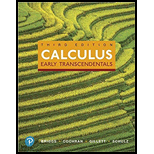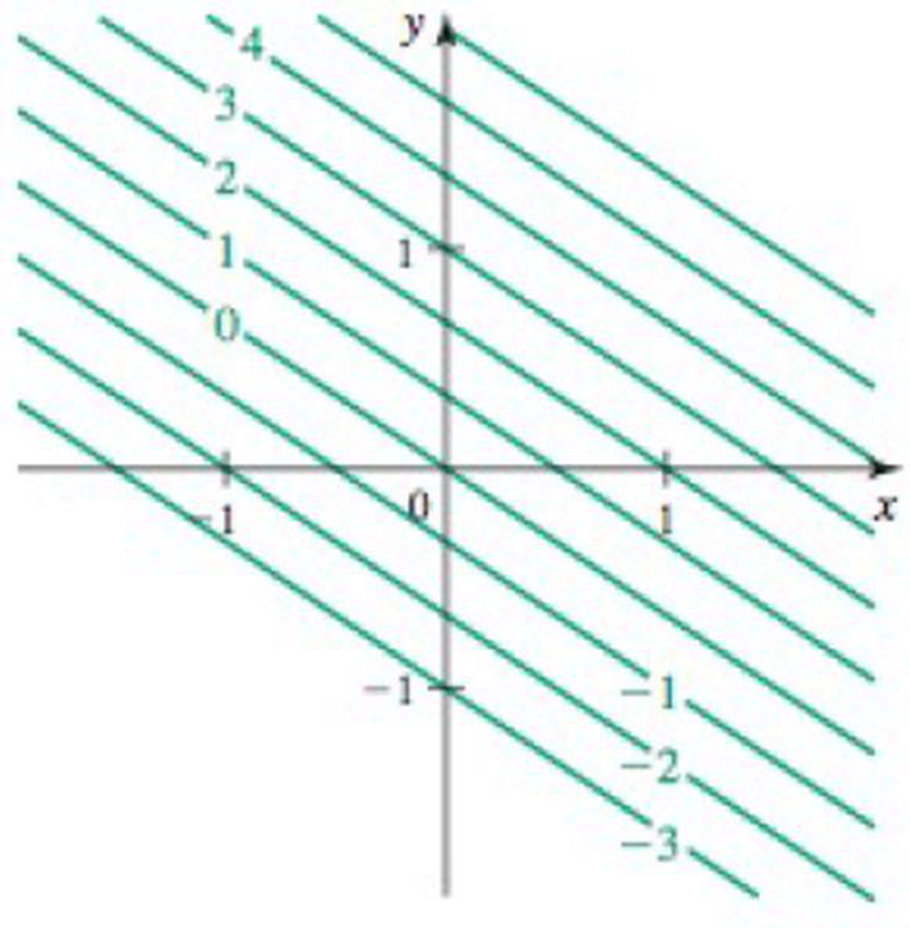
Concept explainers
Equipotential curves Consider the following potential functions and graphs of their equipotential curves.
a. Find the associated gradient field F = ▿ϕ.
b. Show that the
c. Show that the vector field is orthogonal to the equipotential curve at all points (x, y).
d. Sketch two flow curves representing F that are everywhere orthogonal to the equipotential curves.
37. ϕ (x, y) = 2x +3y

Trending nowThis is a popular solution!

Chapter 17 Solutions
CALCULUS:EARLY TRANSCENDENTALS-PACKAGE
Additional Math Textbook Solutions
Calculus: Early Transcendentals (2nd Edition)
Elementary Statistics
Thinking Mathematically (6th Edition)
Elementary Statistics: Picturing the World (7th Edition)
University Calculus: Early Transcendentals (4th Edition)
Pre-Algebra Student Edition
- 3) Prove that in extracting real mode ø, from a complex measured mode o, by maximizing the function: maz | ቀÇቃ | ||.|| ||.||2 is equivalent to the solution obtained from the followings: max Real(e)||2arrow_forwardDraw the unit circle and plot the point P=(8,2). Observe there are TWO lines tangent to the circle passing through the point P. Answer the questions below with 3 decimal places of accuracy. L1 (a) The line L₁ is tangent to the unit circle at the point 0.992 (b) The tangent line 4₁ has equation: y= 0.126 x +0.992 (c) The line L₂ is tangent to the unit circle at the point ( (d) The tangent line L₂ has equation: y= 0.380 x + x × x)arrow_forwardThe cup on the 9th hole of a golf course is located dead center in the middle of a circular green which is 40 feet in radius. Your ball is located as in the picture below. The ball follows a straight line path and exits the green at the right-most edge. Assume the ball travels 8 ft/sec. Introduce coordinates so that the cup is the origin of an xy-coordinate system and start by writing down the equations of the circle and the linear path of the ball. Provide numerical answers below with two decimal places of accuracy. 50 feet green ball 40 feet 9 cup ball path rough (a) The x-coordinate of the position where the ball enters the green will be (b) The ball will exit the green exactly seconds after it is hit. (c) Suppose that L is a line tangent to the boundary of the golf green and parallel to the path of the ball. Let Q be the point where the line is tangent to the circle. Notice that there are two possible positions for Q. Find the possible x-coordinates of Q: smallest x-coordinate =…arrow_forward
- Draw the unit circle and plot the point P=(8,2). Observe there are TWO lines tangent to the circle passing through the point P. Answer the questions below with 3 decimal places of accuracy. P L1 L (a) The line L₁ is tangent to the unit circle at the point (b) The tangent line L₁ has equation: X + (c) The line L₂ is tangent to the unit circle at the point ( (d) The tangent line 42 has equation: y= x + ).arrow_forwardWhat is a solution to a differential equation? We said that a differential equation is an equation that describes the derivative, or derivatives, of a function that is unknown to us. By a solution to a differential equation, we mean simply a function that satisfies this description. 2. Here is a differential equation which describes an unknown position function s(t): ds dt 318 4t+1, ds (a) To check that s(t) = 2t2 + t is a solution to this differential equation, calculate you really do get 4t +1. and check that dt' (b) Is s(t) = 2t2 +++ 4 also a solution to this differential equation? (c) Is s(t)=2t2 + 3t also a solution to this differential equation? ds 1 dt (d) To find all possible solutions, start with the differential equation = 4t + 1, then move dt to the right side of the equation by multiplying, and then integrate both sides. What do you get? (e) Does this differential equation have a unique solution, or an infinite family of solutions?arrow_forwardMinistry of Higher Education & Scientific Research Babylon University College of Engineering - Al musayab Automobile Department Subject :Engineering Analysis Time: 2 hour Date:27-11-2022 کورس اول تحليلات تعمیر ) 1st month exam / 1st semester (2022-2023)/11/27 Note: Answer all questions,all questions have same degree. Q1/: Find the following for three only. 1- 4s C-1 (+2-3)2 (219) 3.0 (6+1)) (+3+5) (82+28-3),2- ,3- 2-1 4- Q2/:Determine the Laplace transform of the function t sint. Q3/: Find the Laplace transform of 1, 0≤t<2, -2t+1, 2≤t<3, f(t) = 3t, t-1, 3≤t 5, t≥ 5 Q4: Find the Fourier series corresponding to the function 0 -5arrow_forwardMinistry of Higher Education & Scientific Research Babylon University College of Engineering - Al musayab Subject :Engineering Analysis Time: 80 min Date:11-12-2022 Automobile Department 2nd month exam / 1" semester (2022-2023) Note: Answer all questions,all questions have same degree. کورس اول شعر 3 Q1/: Use a Power series to solve the differential equation: y" - xy = 0 Q2/:Evaluate using Cauchy's residue theorem, sinnz²+cosz² dz, where C is z = 3 (z-1)(z-2) Q3/:Evaluate dz (z²+4)2 Where C is the circle /z-i/-2,using Cauchy's residue theorem. Examiner: Dr. Wisam N. Hassanarrow_forwardMinistry of Higher Education & Scientific Research Babylon University College of Engineering - Al musayab Subject :Engineering Analysis Time: 80 min Date:11-12-2022 Automobile Department 2nd month exam / 1" semester (2022-2023) Note: Answer all questions,all questions have same degree. کورس اول شعر 3 Q1/: Use a Power series to solve the differential equation: y" - xy = 0 Q2/:Evaluate using Cauchy's residue theorem, sinnz²+cosz² dz, where C is z = 3 (z-1)(z-2) Q3/:Evaluate dz (z²+4)2 Where C is the circle /z-i/-2,using Cauchy's residue theorem. Examiner: Dr. Wisam N. Hassanarrow_forwardWhich degenerate conic is formed when a double cone is sliced through the apex by a plane parallel to the slant edge of the cone?arrow_forward1/ Solve the following: 1 x + X + cos(3X) -75 -1 2 2 (5+1) e 5² + 5 + 1 3 L -1 1 5² (5²+1) 1 5(5-5)arrow_forwardI need expert handwritten solution.to this integralarrow_forwardHow to understand and learn Laurent's serial and what's the point of Laurent's serial And what are the steps of a smooth solution for Laurentarrow_forwardarrow_back_iosSEE MORE QUESTIONSarrow_forward_ios
- Algebra & Trigonometry with Analytic GeometryAlgebraISBN:9781133382119Author:SwokowskiPublisher:Cengage
 Algebra and Trigonometry (MindTap Course List)AlgebraISBN:9781305071742Author:James Stewart, Lothar Redlin, Saleem WatsonPublisher:Cengage Learning
Algebra and Trigonometry (MindTap Course List)AlgebraISBN:9781305071742Author:James Stewart, Lothar Redlin, Saleem WatsonPublisher:Cengage Learning

